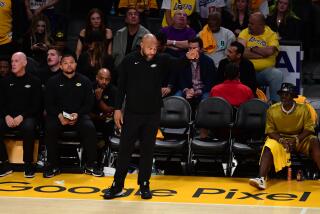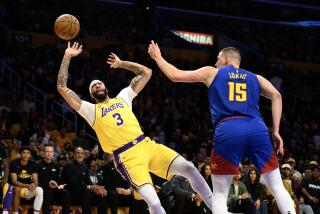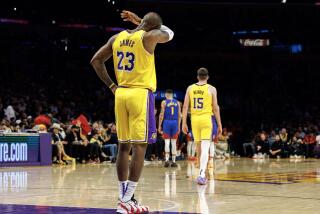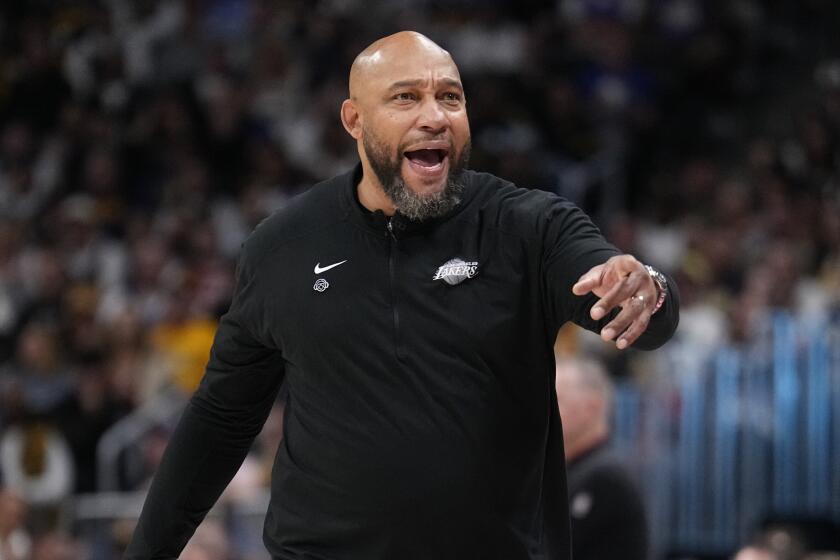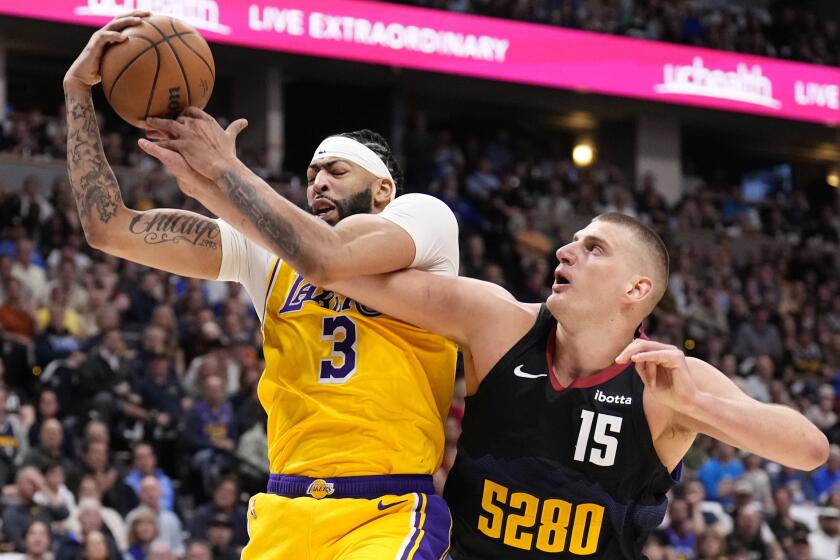Honed Lakers into champions
The Lakers had plenty of talent when Bill Sharman showed up as their new coach in the summer of 1971.
The Hall of Fame lineup included a towering Wilt Chamberlain at center, flanked by Jerry West and Gail Goodrich. What the team lacked -- after years of close misses -- was a championship banner.
A fiercely competitive Sharman changed that.
“There’s a right coach for the right team and the right personnel,” West recalled. “And Bill was certainly the right coach for us.”
Sharman -- who died Friday at 87 -- will be remembered as the man who molded the Lakers into an elite franchise, guiding the 1971-72 squad to a historic 33 consecutive victories and an NBA title, their first in Los Angeles.
It was the crowning moment in a career that saw him achieve fame as an all-star guard for the Boston Celtics, then become a coach who guided teams to championships in three professional basketball leagues.
During his 35 years with the Lakers, he also served as general manager, president and special consultant, making the trade that enabled the franchise to draft Magic Johnson.
His achievements eventually landed him in the Naismith Memorial Basketball Hall of Fame as both a player and coach, a dual honor bestowed upon only two other men, Lenny Wilkens and John Wooden.
“If Bill Sharman isn’t in the Hall of Fame as a coach, no one should be,” his friend Wooden wrote in a recommendation letter.
William Walton Sharman was born on May 25, 1926, in Abilene, Texas, but grew up in Lomita and the San Joaquin Valley, where his father took over a Los Angeles Examiner newspaper distributorship.
Sharman won 15 varsity letters at Porterville High, excelling not only in basketball but also football, baseball, tennis, track and boxing. One day in 1944, he won the discus throw and shot put in a morning track meet, took the San Joaquin Valley tennis title in the afternoon, then pitched the baseball team to victory in the evening.
After a short Navy stint, he was an All-American and Pacific Coast Conference basketball player of the year at USC.
The Brooklyn Dodgers drafted him as an outfielder in 1950 and called him up to the major leagues at the end of the 1951 season. Sharman watched from the dugout as Bobby Thomson of the New York Giants hit the “shot heard ‘round the world” that beat the Dodgers in a pennant playoff.
But, much to his regret, Sharman never made it as a major leaguer. Basketball was his forte.
The old Washington Capitols of the NBA had also drafted him in 1950 and, when that team folded, he landed with the Celtics where former teammate Bob Cousy called him “the best athlete I’ve ever played with, or against.”
The 6-foot-1 guard could shoot and play hard-nosed defense. “He got into more fights than Mike Tyson,” West once remarked. Sharman made the All-Star team eight times during an 11-year NBA career, averaging 17.8 points and winning four titles. Along the way, his uncanny free-throw shooting earned him the nickname “Bull’s-eye Bill.”
His 88.3% average from the line still ranks 12th in NBA history and he led the league in that category seven times.
“Bill Sharman with the basketball at the free throw line was a sports work of art,” Times columnist Jim Murray wrote in 1994. “Ruth with a fastball, Cobb with a base open. Dempsey with his man on the ropes. Hogan with a long par three. Jones with a short putt. Caruso with a high C. Hope in a ‘Road’ movie. Shoemaker on the favorite. Sinatra with Gershwin.
“When it was Sharman at the line, the next sound you heard was swish! It was as foregone as the sun setting.”
In 1961, the L.A. Jets of the American Basketball League hired him as a player-coach, the start of a career change. After the team folded at midseason, officially ending his playing career, Sharman led the Cleveland Pipers to the ABL title in 1961-62, earning lifetime respect from George Steinbrenner, the team’s fledgling owner.
“You always were a winner and you’re still a winner,” the late owner of the New York Yankees once wrote in a letter to Sharman.
When the ABL folded, Sharman coached Cal State L.A. for two seasons, moved to the NBA’s San Francisco Warriors for two more, then took over the L.A. Stars of the new American Basketball Assn. in 1968. The Stars moved to Utah and Sharman guided them to an ABA championship in 1970-71.
It was his second coaching title, and a harbinger of things to come.
That summer, the mercurial owner Jack Kent Cooke hired Sharman to guide the Lakers, a title-starved squad that was considered past its prime.
After moving from Minneapolis to L.A., the team had reached the NBA Finals seven times between 1962 and 1970, always coming up short. Six times they had lost to the Celtics, their hated rivals. Painful to some, perhaps, it took a former Celtic to help them achieve a season for the ages.
In 1971-72, Sharman encouraged his new squad to balance scoring with tireless defense and plenty of running. It was all about surrendering personal glory for shared success.
“Sharman brought a more team-oriented concept,” Goodrich said in 2003. “While the Lakers had great players before, in many ways they relied too much on those great players.”
Goodrich was the top scorer, West led the league in assists and Chamberlain was tops in rebounding. Forwards Happy Hairston and Jim McMillan, who replaced the retired Elgin Baylor, helped trigger the fast break with their rebounding. Guard Goodrich shot the lights out. And everybody played defense.
“If Jerry West wanted to, he could have been the leading scorer on our team, maybe even in the whole league,” Sharman said nearly 25 years later. “Wilt could have led the league in scoring. But everybody sacrificed for the team.”
Nobody seemed to mind.
“I always say he was the easiest coach I ever played for in that he told you what he wanted and demanded of you, and that was it,” West said in 2004 when Sharman was inducted into the Hall of Fame as coach.
During the 1971-72 season, the Lakers averaged 121 points and failed to score more than 100 only once. They defeated the Golden State Warriors by 63, the widest margin in league history at the time.
They also went undefeated from early November to early January, a 33-game streak that set an American pro sports record.
“The funny thing is, a lot of those games weren’t even close,” Sharman said. “It was just an amazing stretch.”
By season’s end, the Lakers had compiled 69-13 record that would stand as the NBA’s best until the Chicago Bulls, led by Michael Jordan, went 72-10 in the 1995-96 season.
But Chamberlain knew that a spectacular regular season wasn’t enough.
“I’ve been on other teams that set records,” he said. “Everything is forgotten if you don’t win it all.”
In the NBA Finals, the Lakers finally got over the hump, defeating the New York Knicks, four games to one. The victory cemented Sharman’s legacy, an influence that continues to be felt around the league.
Midway through his playing career, he had hatched the idea for what is now a staple of NBA life -- the morning shoot-around. At a high school gym outside Boston, he worked out early on the morning of night games, trying to burn off nervous energy.
“I would just go to the gym and take a few shots, but I noticed that I suddenly felt fresher and more confident during games,” he told the Boston Globe in 2004. “So I started doing it for all the games. And my performance was much better.”
After making about 85% of his free throws in his first five seasons with the Celtics, Sharman made 90.3% in the last five. His scoring average also rose and he decided then that if he ever coached, he would spread the word about morning workouts.
Chamberlain wasn’t a big fan of the idea at first, telling Sharman: “You know I don’t like to get up early in the morning.” But a winning streak and a championship helped make shoot-arounds a fixture in the league.
Sharman took the Lakers once more to the NBA Finals, where they lost to the Knicks in 1973, and he coached for three more seasons before his voice, reduced to a whisper from all that shouting, made it impossible for him to continue.
He then took over as general manager, beginning yet another career. In 1996 he was selected as one of the 50 greatest players of the NBA’s first 50 years.
“I think Bill brought an attitude here,” West told The Times in 1988 when Sharman stepped down as team president. “He brought an attitude of work and dedication, and an intensity. In his quiet, nice way he [as coach] instilled in us that we were a better team than the people we played against. We didn’t have that before.”
After suffering a stroke last week, Sharman died at his Redondo Beach home, said his third wife, Joyce. He is also survived by sons Jerry and Tom; daughters Nancy Scott and Janice Hand; six grandchildren and 10 great-grandchildren.
A memorial service is being planned.
--
Crowe is a former Los Angeles Times staff writer.
More to Read
All things Lakers, all the time.
Get all the Lakers news you need in Dan Woike's weekly newsletter.
You may occasionally receive promotional content from the Los Angeles Times.
